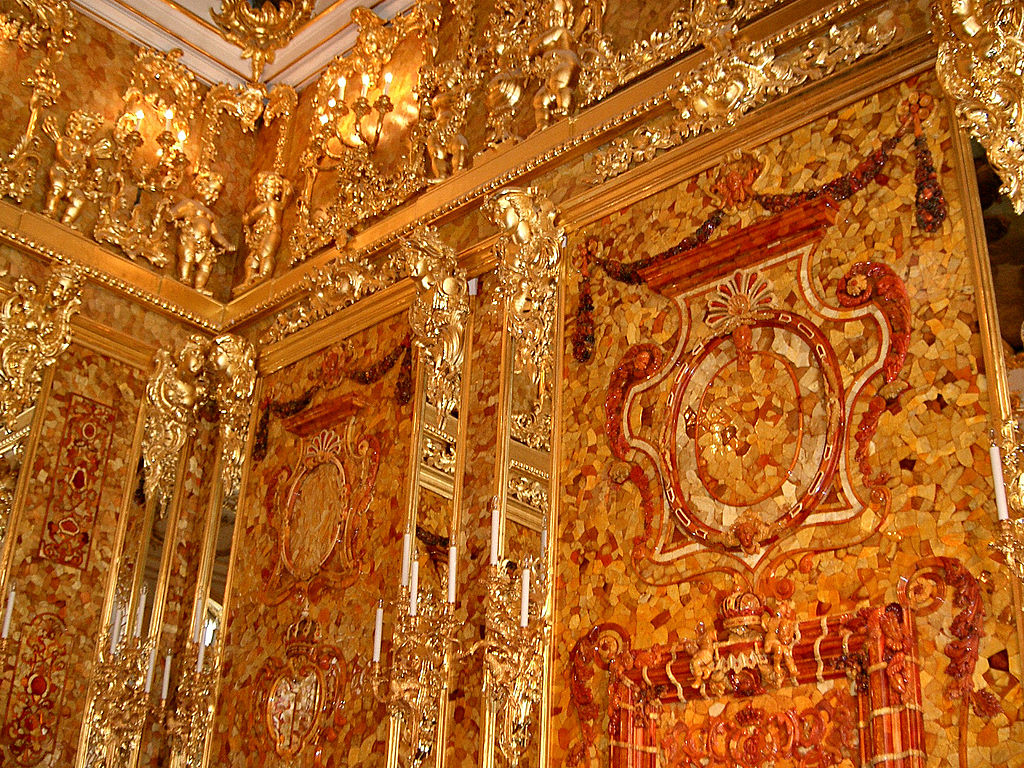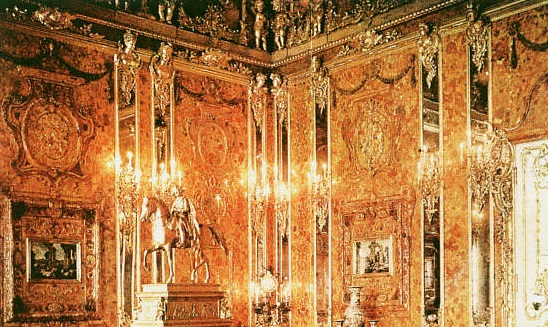Disappearance of Amber Room – Mystery of a Russian Treasure
The story of the Amber Room has intrigued generations of Russophiles and mystery buffs. This Russian treasure, the physical artifact of Peter the Great’s alliance with Prussia, was a feature of the Catherine Palace until St. Petersburg was invaded by Germans in WWII and the panels of the room packed up and shipped to Germany. No one knows what happened to the original Amber Room or if it even still exists. However, a reconstruction of this Petrovian-era masterpiece can be seen today, and its reproduction elicits as many sighs and stops as many hearts as the original did before it was lost.
What Is the Amber Room?
The Amber Room is exactly as its name implies: a room made entirely of amber, that golden resin from the Baltic Sea that has been prized in the region for centuries. Panels, backed with gold and mirrors and covered with pieces of amber, form the walls and decoration of the space in which it was placed by Tsarina Elizabeth in the middle of the 18th century.
Amber, by nature, varies in its hues, from pale, opaque yellow to rich, glowing rust tones. Amber catches the light and amplifies it as anyone who has owned a piece of amber jewelry knows. An entire room of amber basks the occupant in radiance, which is emphasized with the addition of decorative golden scrolls and a floor polished to a high shine.
The Amber Room was actually designed and created in Prussia. During a visit, Peter the Great expressed his appreciation for the room. Never one to shun luxury, Peter was no doubt attracted to the unusual lambency the use of this precious material lent the space. Friedrich Wilhelm I presented it to the Russian emperor as a gift and a Russian-Prussian alliance against Sweden was formed. All Russian tsars since that time enjoyed the gift whenever they visited Tsarskoe Selo.

The Amber Room (In English sometimes known as Amber Chamber, German: Bernsteinzimmer) in the Catherine Palace of Tsarskoye Selo near Saint Petersburg is a complete chamber decoration of amber panels backed with gold leaf and mirrors. Due to its singular beauty, it was sometimes dubbed the “Eighth Wonder of the World”.
Before it was lost, the original Amber Room represented a joint effort of German and Russian craftsmen. Construction of the Amber Room began in 1701 to 1709 in Prussia. The room was designed by German baroque sculptor Andreas Schlüter and constructed by the Danish amber craftsman Gottfried Wolfram and remained at Charlottenburg Palace until 1716 when it was given by Prussian king Friedrich Wilhelm I to his then ally, Tsar Peter the Great of the Russian Empire. In Russia it was expanded and after several renovations, it covered more than 55 square meters and contained over six tons of amber. The Amber Room was looted during World War II by Nazi Germany and brought to Königsberg. Knowledge of its whereabouts was lost in the chaos at the end of the war.
In 1979 efforts began to rebuild the Amber room at Tsarskoye Selo. In 2003, after decades of work by Russian craftsmen, financed by donations from Germany, the reconstructed Amber Room was inaugurated in the Catherine Palace in Saint Petersburg, Russia.
The Baltic region is known to contain huge deposits of amber. In fact, some estimates claim up to 80% of the world’s supply of the fossilized tree resin is located there. Its warm, golden glow is prized by artists and collectors alike. The highest quality of amber has been used for ornamental and jewelry production since Neolithic times.
Perhaps the best known and inspired use of amber was the creation of the Amber Room in 1709 by designer Andreas Schluter and amber craftsman Gottfried Wolfram.
Upon completion, the Amber Room was proudly displayed at the Charlottenberg Palace in Prussia. It was considered a true masterpiece. During a visit to Prussia in 1712, Czar Peter the Great of Russia confided in King Friedrich Wilhelm I on how much he adored this stunning room. In order to cement an alliance against Sweden, King Wilhelm I presented the Amber Room as a gift to Czar Peter the Great. The royal gift was shipped over water to Russia in 18 large boxes in 1716.
Once in Russia, the Amber Room was further built upon and renovated. In its final form in 1763, the Amber Room spanned 55 meters and contained over six tons of amber. It was located in the Catherine Palace of St. Petersburg and admired by the lucky few who were able to see it. The feeling one would get visiting the Amber Room can be described as the following:
“When the daylight was shining through the wide windows, it replaced hundreds of lighting candles and created thousands of reflections in the mirrors. This light made multicolored Amber walls shine more beautiful than gold and created a deeply lasting impression never forgotten by any visitor.”
Most words cannot describe the awe someone would feel while in this room. In fact, many considered the Amber Room the “Eighth Wonder of the World”.
The Amber Room would stay in Saint Petersburg (known as Leningrad at this time) until 1941. In that year, Germany invaded the Soviet Union in Operation Barbarossa. As part of the occupation on Soviet territory, the acquisition of all arts and treasures back to Germany was of highest priority.
When Leningrad (formerly St. Petersburg) was about to fall to German forces in 1941, efforts to transport the Amber Room to a safer location failed. The dried and fragile amber would crumble when handled. The only course of action for the curators in saving the room was to place wallpaper over the amber walls and disguise it as any other typical room.
This fooled no one as the Germans were well aware of the location of the Amber Room. Within 36 hours, the Amber Room was dismantled and placed inside 27 crates on 18 trucks. It was transported to Königsberg castle in East Prussia, where it was reassembled and opened for exhibition in March, 1942.
The war would not stay in Germany’s favor for long. In 1945, Königsberg was heavily damaged by Royal Air Force bombers and on April 9, 1945, the Soviets advanced into Königsberg, setting the city ablaze. Since spring of 1944, the Amber Room has never been seen again.
THEORIES AS TO WHAT HAPPENED TO THE AMBER ROOM
* According to records, Hitler ordered the transfer of looted possessions to safer locations on 21 and 24 January 1945. Eyeswitnesses support a theory that the Amber Room was disassembled again and placed on crates at a railway station. The Amber Room was then placed aboard the Wilhelm Gustloff, which left port on January 30,1945.
The Wilhelm Gustloff was sunk shortly thereafter by a Soviet submarine.
* The Amber Room was hidden in a basement bunker in Königsberg, which has since been sealed off and inaccessible to the general public.
* Another theory is that the Amber Room was buried in a mine in the Ore Mountains.
The most likely scenario is that the Amber Room was destroyed in the Königsberg castle blaze following the Soviet occupation of the city. The Russian leadership flatly denies this accusation, but researchers claim there are a variety of reasons the then Soviet government denied destroying this work of art. The main motives of their denial is strictly political: to deflect guilt for the destruction of this masterpiece by their own hands and to use as leverage on any grievances placed on Germany following the conclusion of the war.
Pieces of the Amber Room have been found since 1945. The most recent in 1997, when one of the four stone mosaics that was used to decorate the room was recovered in western Germany. It was in the possession of the family of one of the soldiers who packed it up.
However, multiple searches continue for the possibility that the Amber Room was salvaged. Avenir Ovsyanov, an official on the search for missing art with Kaliningrad’s regional government, stated some portions of the Amber Room did burn in the Königsberg castle, but most of it was likely taken away by the Nazis before the Soviet’s had time to secure the city.
While the search for this original work of art continues, a reconstruction effort using mostly black and white photographs was undertaken to recreate the Amber Room. On the 300th anniversary of St. Petersburg, the new Amber Room was was dedicated to Russian President Vladimir Putin and German Chancellor Gerhard Schröder.
As to what fate the original Amber Room actually had, that is still in dispute. However, those who understand the nature of amber will tell you that if it’s not properly cared for, it will become brittle and crumble into dust. If the Amber Room did survive the inferno, it has most likely returned back into the earth from which it came.



